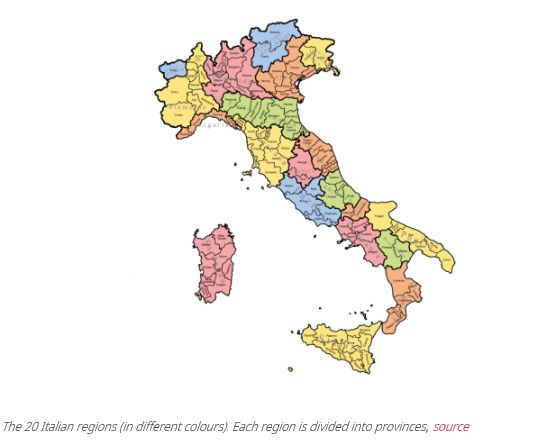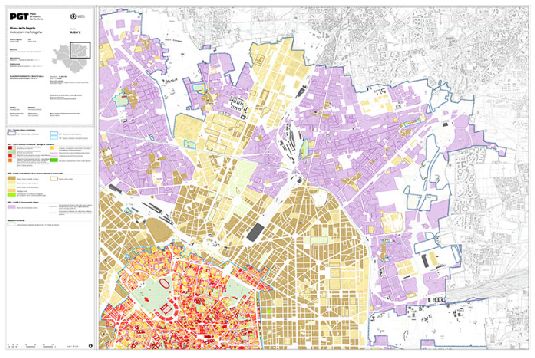In Italy there are no megalopolises, just medium-large cities. The largest are Rome (around 2.8 million inhabitants) and Milan (around 1.3 million inhabitants), and there are various levels of land-use planning authorities and procedures to consider.
In Italy, different levels of government (20 regions, 103 provinces, over 8,000 municipalities) have land-use planning tasks assigned to them:
- The state has the power to set general rules.
- The regions legislate their own regional laws in the frameworks of national law.
- The provinces have competence on some aspects of territorial planning, mainly related to geological and environmental aspects.
The Regional laws have introduced different names for the municipal masterplans. Here there are some examples:

The municipalities are the central point in the definition of programmes for development and transformation of land and approve the General Town Planning Masterplan (Piano Regolatore Generale).
The General Planning Masterplan
The General Planning Masterplan classifies the municipal territory into areas attributing to each of them different features, permitted uses and building characters. The decision-making power of each municipality to designate the areas and regulate the discipline applicable to them is very wide and discretionary.
The most common divisions of municipal territory are:
- areas of historical origin;
- areas totally or partially built up, thus considered semi-developed zones (zone di completamento), which can be further developed for residential or industrial functions;
- areas for agricultural purposes; and
- areas with the purpose of hosting structures of public use (hospitals, schools, public offices etc.).
|
Lombardy |
Plan for the Government of the Territory (Piano di Governo del Territorio), which is divided into three sections: the document for the general strategic decisions of the city; the plan which settles the local rules; and the plan which regulates public services. |
|
Emilia Romagna
|
Starting from 2020, the masterplan will be the PUG (General
Urban Plan – Piano Urbanistico Generale). Now, the masterplan is composed by the PSC (Structural Plan – Piano strutturale comunale) which rules the strategic decisions for the city and the RUE (Building Regulation – regolamento urbanistico edilizio) which regulates the building rules in each area. |
| Campania |
The PUC – Piano Urbanistico Comunale (Municipal Urban Plan): one sole plan for the various aspects of the discipline. |
|
Veneto |
Piano Assetto del Territorio (PAT, Plan for the territorial layout), which rules the general strategic decisions and the Piano degli interventi (PI – Plan for the Interventions), which contains the building discipline. |
| Toscana |
The Piano Strutturale (PS – Structural Plan) contains the general strategic decisions of the Municipality and the Regolamento Urbanistico (RU – Urban Regulation) contains the building discipline. |
An example: The municipality of Milan
The following picture is a section of the North East Section of the Municipality of Milan, as ruled by the Plan of the Rules (Piano delle Regole) of the masterplan.

The zoning and building discipline is different for each area. The General Planning Masterplan regulates specific city planning parameters, such as the territorial and land utilization capacity, legal distances, building heights, compatible uses, etc., for each municipal area.
The General Planning Instrument Masterplan can also establish building limitations; it identifies the already built-up areas where relevant physical changes are not possible (only maintenance and restoration) or where more radical changes (such as demolition and reconstruction are forbidden). The General Planning Masterplan is approved by the Municipal Council. The approval procedure is settled by each Italian region: the main aspect of these procedures is the obtainment of the formal approval of the regions and of the provinces of the masterplan to the extent to have the check of the compliance of the municipal regulation with the goals of the territorial tools of these superior entities.
From zoning discipline to building activity
The General Planning Instrument Masterplan can be implemented in two main ways:
- If the discipline of the zoning area is already well determined at construction level, by obtaining a building permit.
- If the discipline of the zoning area is only outlined by the General Planning Instrument, its development must be secured through Development Plans (Piani Attuativi) of private or public initiatives before building titles are granted.
The Development Plan has to be approved by the municipality upon receiving a project plan concerning the entire area of development. Once it is approved, the owners enter into a town planning agreement (Convenzione Urbanistica) with the municipality, which rules on the obligations of the landowners concerning the way to develop the area (i.e. providing essential functions for use, such as the construction of utilities and the further infrastructure, such as sports fields, that allow the area to be used to full capacity).
The content of this article is intended to provide a general guide to the subject matter. Specialist advice should be sought about your specific circumstances.
[View Source]

